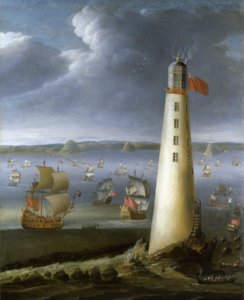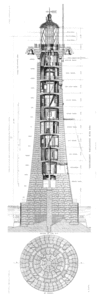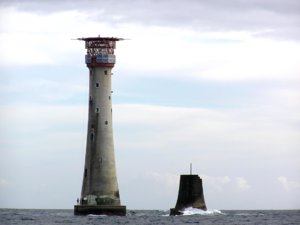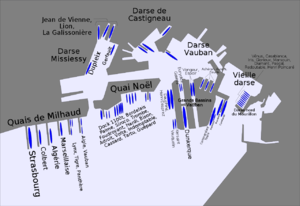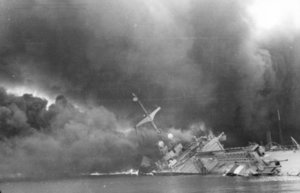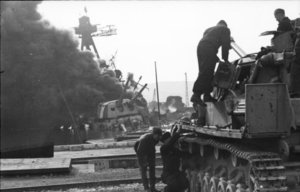Today in Naval History - Naval / Maritime Events in History
12th of November
some of the events you will find here,
please use the following link where you will find more details and all other events of this day .....
1595 – Death of John Hawkins, English admiral and shipbuilder (b. 1532)
Admiral Sir John Hawkins (also spelled as Hawkyns) (1532 – 12 November 1595) was an English slave trader, naval commander and administrator, merchant, navigator, shipbuilder and privateer. His elder brother and trading partner was William (b. c. 1519). He was considered the first English trader to profit from the Triangle Trade, based on selling supplies to colonies ill-supplied by their home countries, and their demand for African slaves in the Spanish colonies of Santo Domingo and Venezuela in the late 16th century. He styled himself "Captain General" as the General of both his own flotilla of ships and those of the English Royal Navy and to distinguish himself from those Admirals that served only in the administrative sense and were not military in nature. His death and that of his second cousin and mentoree, Sir Francis Drake, heralded the decline of the Royal Navy for decades before its recovery and eventual dominance again helped by the propaganda of the Navy's glory days under his leadership.

1684 – Birth of Edward Vernon, English admiral and politician (d. 1757)
Admiral Edward Vernon (12 November 1684 – 30 October 1757) was an English naval officer. He had a long and distinguished career, rising to the rank of admiral after 46 years service. As a vice admiral during the War of Jenkins' Ear, in 1739 he was responsible for the capture of Porto Bello, seen as expunging the failure of Admiral Hosier there in a previous conflict. However, his later amphibious operation against Cartagena de Indias suffered a severe defeat. Vernon also served as a Member of Parliament (MP) on three occasions and was out-spoken on naval matters in Parliament, making him a controversial figure.
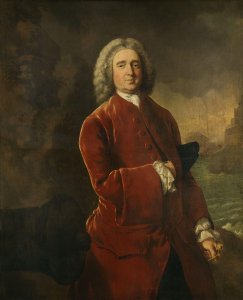
1729 – Birth of Louis Antoine de Bougainville, French admiral and explorer (d. 1811)
Louis-Antoine, Comte de Bougainville (12 November 1729 – 31 August 1811) was a French admiral and explorer. A contemporary of the British explorer James Cook, he took part in the Seven Years' War in North America and the American Revolutionary War against Britain. Bougainville later gained fame for his expeditions, including circumnavigation of the globe in a scientific expedition in 1763, the first recorded settlement on the Falkland Islands, and voyages into the Pacific Ocean. Bougainville Island of Papua New Guinea as well as the Bougainvillea flower were named after him.

1795 - HMS Fleche (1768 - 14) wrecked on reef of Rocks off Fernelli Tower, Saint Fiorenzo's Bay, Mediterranean.
Fleche was a French corvette built by Louis-Hilarion Chapelle (cadet) and launched at Toulon in 1768. The British captured her at the Fall of Bastia in May 1794 and commissioned her into the Royal Navy under her existing name. She observed the naval battle of Hyères Islands, but then wrecked in 1795.
1797 - HMS Cerberus (1794 - 32), Cptn. J. Drew, captured French ship-privateer Epervier (1788 - 16) and French privateer Renard (1797 - 18) and recaptured Adelphi, prize to Epervier
HMS Cerberus was a 32-gun fifth-rate frigate of the Royal Navy. She served in the French Revolutionary and the Napoleonic Wars in the Channel, the Mediterranean, the Adriatic, and even briefly in the Baltic against the Russians. She participated in one boat action that won for her crew a clasp to the Naval General Service Medal (NGSM). She also captured many privateers and merchant vessels. Her biggest battle was the Battle of Lissa, which won for her crew another clasp to the NGSM. She was sold in 1814.

1806 - Boats of HMS Galatea (1794 - 32), Cptn. George Sayer, captured schooner Reunion (10), off Guadeloupe.
HMS Galatea was a fifth-rate 32-gun sailing frigate of the British Royal Navy that George Parsons built at Bursledon and launched in 1794. Before she was broken up in 1809 she captured numerous prizes and participated in a number of actions, first in the Channel and off Ireland (1794–1803), and then in the Caribbean (1802–1809), including one that earned her crew the Naval General Service Medal.

1810 - Start of engagement by HMS Diana (38), HMS Niobe (38), HMS Donegal (80), and HMS Revenge (74) engaged 2 French frigates Elisa and Amazone which went ashore at La Hogue and Tatillon.
The Action of 15 November 1810 was a minor naval engagement fought during the British Royal Navy blockade of the French Channel ports in the Napoleonic Wars. British dominance at sea, enforced by a strategy of close blockade, made it difficult for the French Navy to operate even in their own territorial waters. In the autumn of 1810, a British squadron assigned to patrol the Baie de la Seine was effectively isolating two French squadrons in the ports of Le Havre and Cherbourg. On 12 November, the squadron in Le Havre, consisting of frigates Elisa and Amazone attempted to reach Cherbourg at night in order to united the squadrons. This squadron was spotted in the early hours of 13 November by the patrolling British frigates HMS Diana and HMS Niobe, which gave chase.
The French ships took shelter at the heavily fortified Iles Saint-Marcouf, sailing the following morning for the anchorage at Saint-Vaast-la-Hougue. For two days the British frigates kept watch, until two ships of the line from the blockade of Cherbourg, HMS Donegal and HMS Revenge, arrived. On 15 November, the British squadron attacked the anchored French ships, which were defended by shore batteries at La Hougue and Tatihou. After four attempts to close with the French the British squadron, under heavy fire, withdrew. During the night, the British commander, Captain Pulteney Malcolm, sent his ship's boats close inshore to attack the French ships with Congreve rockets, a newly issued weapon. None are recorded as landing on target, but by morning both frigates had been forced to change position, becoming grounded on the shore. The French ships were later refloated, and Malcolm's squadron maintained the blockade until 27 November when Amazone successfully escaped back to Le Havre. The damaged Elisa remained at anchor until 6 December, when an attack by a British bomb vessel forced the frigate to move further inshore, becoming grounded once more. Elisa remained in this position until 23 December, when the boats of Diana entered the anchorage at night and set the beached ship on fire, destroying her.
1893 – Launch of Tri Sviatitelia (Russian: Три Святителя meaning the Three Holy Hierarchs), a pre-dreadnought battleship built for the Imperial Russian Navy
Tri Sviatitelia (Russian: Три Святителя meaning the Three Holy Hierarchs) was a pre-dreadnought battleship built for the Imperial Russian Navy during the 1890s. She served with the Black Sea Fleet and was flagship of the forces pursuing the mutinous battleship Potemkin in June 1905. During World War I the ship encountered the German battlecruiser SMS Goeben (formally Yavuz Sultan Selim) twice, but never hit the German ship, nor was she damaged by her. From 1915 onward she was relegated to the coast bombardment role as she was the oldest battleship in the Black Sea Fleet. Tri Sviatitelia was refitting in Sevastopol when the February Revolution of 1917 began and she was never operational afterwards.
Tri Sviatitelia was captured when the Germans took the city in May 1918 and was turned over to the Allies after the Armistice in November 1918. Her engines were destroyed in 1919 by the British when they withdrew from Sevastopol to prevent the advancing Bolsheviks from using her against the White Russians. She was abandoned when the Whites evacuated the Crimea in 1920 and was scrapped in 1923.

1928 – SS Vestris sinks approximately 200 miles (320 km) off Hampton Roads, Virginia, killing at least 110 passengers, mostly women and children who die after the vessel is abandoned.
SS Vestris was a 1912 passenger steamship owned by Lamport and Holt Line and used in their New York to River Plate service. On 12 November 1928 she began listing about 200 miles off Hampton Roads, Virginia, was abandoned, and sank, killing more than 100 people. Her wreck is thought to rest some 1.2 miles (2 km) beneath the North Atlantic.


1934 – Panzerschiff SMS Admiral Scheer commissioned
Admiral Scheer was a Deutschland-class heavy cruiser (often termed a pocket battleship) which served with the Kriegsmarine of Nazi Germany during World War II. The vessel was named after Admiral Reinhard Scheer, German commander in the Battle of Jutland. She was laid down at the Reichsmarinewerft shipyard in Wilhelmshaven in June 1931 and completed by November 1934. Originally classified as an armored ship (Panzerschiff) by the Reichsmarine, in February 1940 the Germans reclassified the remaining two ships of this class as heavy cruisers.

1940 - Battle of Taranto
The Battle of Taranto took place on the night of 11–12 November 1940 during the Second World War between British naval forces, under Admiral Andrew Cunningham, and Italian naval forces, under Admiral Inigo Campioni. The Royal Navy launched the first all-aircraft ship-to-ship naval attack in history, employing 21 obsolete Fairey Swordfish biplane torpedo bombers from the aircraft carrier HMS Illustrious in the Mediterranean Sea. The attack struck the battle fleet of the Regia Marina at anchor in the harbour of Taranto, using aerial torpedoes despite the shallowness of the water. The success of this attack augured the ascendancy of naval aviation over the big guns of battleships. According to Admiral Cunningham, "Taranto, and the night of 11–12 November 1940, should be remembered for ever as having shown once and for all that in the Fleet Air Arm the Navy has its most devastating weapon."

1940 - Battle of the Strait of Otranto
The Battle of the Strait of Otranto was a minor naval skirmish on 12 November 1940 during the Battle of the Mediterranean in World War II. It took place in the Strait of Otranto in the Adriatic Sea, between Italy and Albania.

Ramb III, the only surviving participant in the battle, is on display at Rijeka as the museum ship Galeb.
1942 – World War II: Naval Battle of Guadalcanal between Japanese and American forces near Guadalcanal - Day 1
The Naval Battle of Guadalcanal, sometimes referred to as the Third and Fourth Battles of Savo Island, the Battle of the Solomons, the Battle of Friday the 13th, or, in Japanese sources, the Third Battle of the Solomon Sea (第三次ソロモン海戦 Dai-san-ji Soromon Kaisen), took place from 12–15 November 1942, and was the decisive engagement in a series of naval battles between Allied (primarily American) and Imperial Japanese forces during the months-long Guadalcanal Campaign in the Solomon Islands during World War II. The action consisted of combined air and sea engagements over four days, most near Guadalcanal and all related to a Japanese effort to reinforce land forces on the island. The only two U.S. Navy admirals to be killed in a surface engagement in the war were lost in this battle.

1944 – World War II: Operation Catechism - The Royal Air Force launches 29 Avro Lancaster bombers, which sink the German battleship Tirpitz, with 12,000 lb Tallboy bombs off Tromsø, Norway.
Operation Catechism was the last of nine attempts to sink or sabotage the Kriegsmarine battleship Tirpitz during the Second World War. The ship was finally sunk in this attempt.

1965 - SS Yarmouth Castle burning
SS Yarmouth Castle was an American steamship whose loss in a disastrous fire in 1965 prompted new laws regarding safety at sea.

12th of November
some of the events you will find here,
please use the following link where you will find more details and all other events of this day .....
Naval/Maritime History - 11th of April - Today in Naval History - Naval / Maritime Events in History
Today in Naval History - Naval / Maritime Events in History 11 November 1776 – Launch of French Fendant 74, designed by Antoine Groignard, at Rochefort – condemned and broken up 1785 at Mauritius. The Fendant was a 74-gun ship of the line of the French Navy. Designed by Antoine Groignard, she...
shipsofscale.com
1595 – Death of John Hawkins, English admiral and shipbuilder (b. 1532)
Admiral Sir John Hawkins (also spelled as Hawkyns) (1532 – 12 November 1595) was an English slave trader, naval commander and administrator, merchant, navigator, shipbuilder and privateer. His elder brother and trading partner was William (b. c. 1519). He was considered the first English trader to profit from the Triangle Trade, based on selling supplies to colonies ill-supplied by their home countries, and their demand for African slaves in the Spanish colonies of Santo Domingo and Venezuela in the late 16th century. He styled himself "Captain General" as the General of both his own flotilla of ships and those of the English Royal Navy and to distinguish himself from those Admirals that served only in the administrative sense and were not military in nature. His death and that of his second cousin and mentoree, Sir Francis Drake, heralded the decline of the Royal Navy for decades before its recovery and eventual dominance again helped by the propaganda of the Navy's glory days under his leadership.

1684 – Birth of Edward Vernon, English admiral and politician (d. 1757)
Admiral Edward Vernon (12 November 1684 – 30 October 1757) was an English naval officer. He had a long and distinguished career, rising to the rank of admiral after 46 years service. As a vice admiral during the War of Jenkins' Ear, in 1739 he was responsible for the capture of Porto Bello, seen as expunging the failure of Admiral Hosier there in a previous conflict. However, his later amphibious operation against Cartagena de Indias suffered a severe defeat. Vernon also served as a Member of Parliament (MP) on three occasions and was out-spoken on naval matters in Parliament, making him a controversial figure.

1729 – Birth of Louis Antoine de Bougainville, French admiral and explorer (d. 1811)
Louis-Antoine, Comte de Bougainville (12 November 1729 – 31 August 1811) was a French admiral and explorer. A contemporary of the British explorer James Cook, he took part in the Seven Years' War in North America and the American Revolutionary War against Britain. Bougainville later gained fame for his expeditions, including circumnavigation of the globe in a scientific expedition in 1763, the first recorded settlement on the Falkland Islands, and voyages into the Pacific Ocean. Bougainville Island of Papua New Guinea as well as the Bougainvillea flower were named after him.

1795 - HMS Fleche (1768 - 14) wrecked on reef of Rocks off Fernelli Tower, Saint Fiorenzo's Bay, Mediterranean.
Fleche was a French corvette built by Louis-Hilarion Chapelle (cadet) and launched at Toulon in 1768. The British captured her at the Fall of Bastia in May 1794 and commissioned her into the Royal Navy under her existing name. She observed the naval battle of Hyères Islands, but then wrecked in 1795.
1797 - HMS Cerberus (1794 - 32), Cptn. J. Drew, captured French ship-privateer Epervier (1788 - 16) and French privateer Renard (1797 - 18) and recaptured Adelphi, prize to Epervier
HMS Cerberus was a 32-gun fifth-rate frigate of the Royal Navy. She served in the French Revolutionary and the Napoleonic Wars in the Channel, the Mediterranean, the Adriatic, and even briefly in the Baltic against the Russians. She participated in one boat action that won for her crew a clasp to the Naval General Service Medal (NGSM). She also captured many privateers and merchant vessels. Her biggest battle was the Battle of Lissa, which won for her crew another clasp to the NGSM. She was sold in 1814.
1806 - Boats of HMS Galatea (1794 - 32), Cptn. George Sayer, captured schooner Reunion (10), off Guadeloupe.
HMS Galatea was a fifth-rate 32-gun sailing frigate of the British Royal Navy that George Parsons built at Bursledon and launched in 1794. Before she was broken up in 1809 she captured numerous prizes and participated in a number of actions, first in the Channel and off Ireland (1794–1803), and then in the Caribbean (1802–1809), including one that earned her crew the Naval General Service Medal.
1810 - Start of engagement by HMS Diana (38), HMS Niobe (38), HMS Donegal (80), and HMS Revenge (74) engaged 2 French frigates Elisa and Amazone which went ashore at La Hogue and Tatillon.
The Action of 15 November 1810 was a minor naval engagement fought during the British Royal Navy blockade of the French Channel ports in the Napoleonic Wars. British dominance at sea, enforced by a strategy of close blockade, made it difficult for the French Navy to operate even in their own territorial waters. In the autumn of 1810, a British squadron assigned to patrol the Baie de la Seine was effectively isolating two French squadrons in the ports of Le Havre and Cherbourg. On 12 November, the squadron in Le Havre, consisting of frigates Elisa and Amazone attempted to reach Cherbourg at night in order to united the squadrons. This squadron was spotted in the early hours of 13 November by the patrolling British frigates HMS Diana and HMS Niobe, which gave chase.
The French ships took shelter at the heavily fortified Iles Saint-Marcouf, sailing the following morning for the anchorage at Saint-Vaast-la-Hougue. For two days the British frigates kept watch, until two ships of the line from the blockade of Cherbourg, HMS Donegal and HMS Revenge, arrived. On 15 November, the British squadron attacked the anchored French ships, which were defended by shore batteries at La Hougue and Tatihou. After four attempts to close with the French the British squadron, under heavy fire, withdrew. During the night, the British commander, Captain Pulteney Malcolm, sent his ship's boats close inshore to attack the French ships with Congreve rockets, a newly issued weapon. None are recorded as landing on target, but by morning both frigates had been forced to change position, becoming grounded on the shore. The French ships were later refloated, and Malcolm's squadron maintained the blockade until 27 November when Amazone successfully escaped back to Le Havre. The damaged Elisa remained at anchor until 6 December, when an attack by a British bomb vessel forced the frigate to move further inshore, becoming grounded once more. Elisa remained in this position until 23 December, when the boats of Diana entered the anchorage at night and set the beached ship on fire, destroying her.
1893 – Launch of Tri Sviatitelia (Russian: Три Святителя meaning the Three Holy Hierarchs), a pre-dreadnought battleship built for the Imperial Russian Navy
Tri Sviatitelia (Russian: Три Святителя meaning the Three Holy Hierarchs) was a pre-dreadnought battleship built for the Imperial Russian Navy during the 1890s. She served with the Black Sea Fleet and was flagship of the forces pursuing the mutinous battleship Potemkin in June 1905. During World War I the ship encountered the German battlecruiser SMS Goeben (formally Yavuz Sultan Selim) twice, but never hit the German ship, nor was she damaged by her. From 1915 onward she was relegated to the coast bombardment role as she was the oldest battleship in the Black Sea Fleet. Tri Sviatitelia was refitting in Sevastopol when the February Revolution of 1917 began and she was never operational afterwards.
Tri Sviatitelia was captured when the Germans took the city in May 1918 and was turned over to the Allies after the Armistice in November 1918. Her engines were destroyed in 1919 by the British when they withdrew from Sevastopol to prevent the advancing Bolsheviks from using her against the White Russians. She was abandoned when the Whites evacuated the Crimea in 1920 and was scrapped in 1923.
1928 – SS Vestris sinks approximately 200 miles (320 km) off Hampton Roads, Virginia, killing at least 110 passengers, mostly women and children who die after the vessel is abandoned.
SS Vestris was a 1912 passenger steamship owned by Lamport and Holt Line and used in their New York to River Plate service. On 12 November 1928 she began listing about 200 miles off Hampton Roads, Virginia, was abandoned, and sank, killing more than 100 people. Her wreck is thought to rest some 1.2 miles (2 km) beneath the North Atlantic.
1934 – Panzerschiff SMS Admiral Scheer commissioned
Admiral Scheer was a Deutschland-class heavy cruiser (often termed a pocket battleship) which served with the Kriegsmarine of Nazi Germany during World War II. The vessel was named after Admiral Reinhard Scheer, German commander in the Battle of Jutland. She was laid down at the Reichsmarinewerft shipyard in Wilhelmshaven in June 1931 and completed by November 1934. Originally classified as an armored ship (Panzerschiff) by the Reichsmarine, in February 1940 the Germans reclassified the remaining two ships of this class as heavy cruisers.
1940 - Battle of Taranto
The Battle of Taranto took place on the night of 11–12 November 1940 during the Second World War between British naval forces, under Admiral Andrew Cunningham, and Italian naval forces, under Admiral Inigo Campioni. The Royal Navy launched the first all-aircraft ship-to-ship naval attack in history, employing 21 obsolete Fairey Swordfish biplane torpedo bombers from the aircraft carrier HMS Illustrious in the Mediterranean Sea. The attack struck the battle fleet of the Regia Marina at anchor in the harbour of Taranto, using aerial torpedoes despite the shallowness of the water. The success of this attack augured the ascendancy of naval aviation over the big guns of battleships. According to Admiral Cunningham, "Taranto, and the night of 11–12 November 1940, should be remembered for ever as having shown once and for all that in the Fleet Air Arm the Navy has its most devastating weapon."
1940 - Battle of the Strait of Otranto
The Battle of the Strait of Otranto was a minor naval skirmish on 12 November 1940 during the Battle of the Mediterranean in World War II. It took place in the Strait of Otranto in the Adriatic Sea, between Italy and Albania.
Ramb III, the only surviving participant in the battle, is on display at Rijeka as the museum ship Galeb.
1942 – World War II: Naval Battle of Guadalcanal between Japanese and American forces near Guadalcanal - Day 1
The Naval Battle of Guadalcanal, sometimes referred to as the Third and Fourth Battles of Savo Island, the Battle of the Solomons, the Battle of Friday the 13th, or, in Japanese sources, the Third Battle of the Solomon Sea (第三次ソロモン海戦 Dai-san-ji Soromon Kaisen), took place from 12–15 November 1942, and was the decisive engagement in a series of naval battles between Allied (primarily American) and Imperial Japanese forces during the months-long Guadalcanal Campaign in the Solomon Islands during World War II. The action consisted of combined air and sea engagements over four days, most near Guadalcanal and all related to a Japanese effort to reinforce land forces on the island. The only two U.S. Navy admirals to be killed in a surface engagement in the war were lost in this battle.
1944 – World War II: Operation Catechism - The Royal Air Force launches 29 Avro Lancaster bombers, which sink the German battleship Tirpitz, with 12,000 lb Tallboy bombs off Tromsø, Norway.
Operation Catechism was the last of nine attempts to sink or sabotage the Kriegsmarine battleship Tirpitz during the Second World War. The ship was finally sunk in this attempt.
1965 - SS Yarmouth Castle burning
SS Yarmouth Castle was an American steamship whose loss in a disastrous fire in 1965 prompted new laws regarding safety at sea.


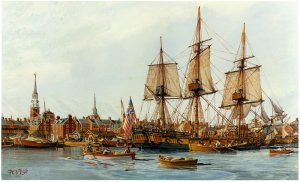
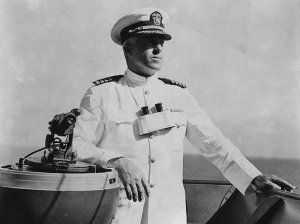

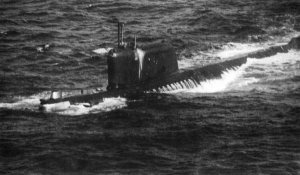
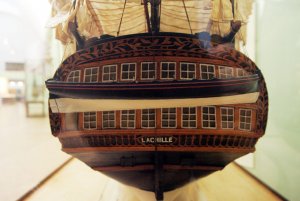
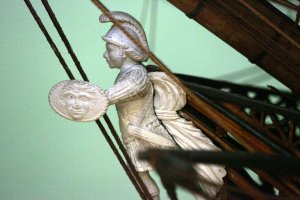
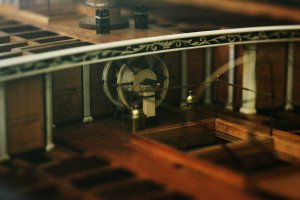
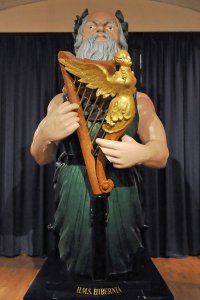
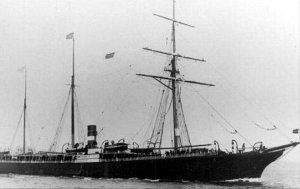
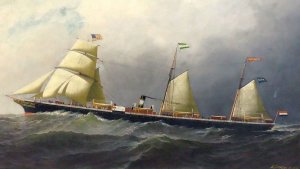

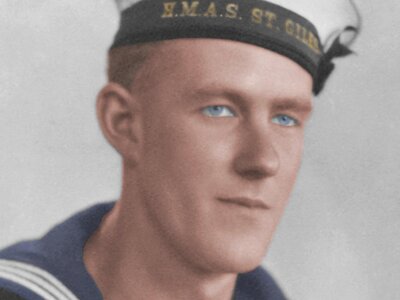
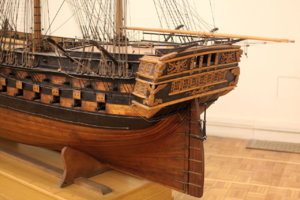
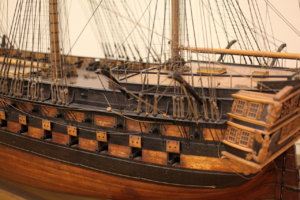
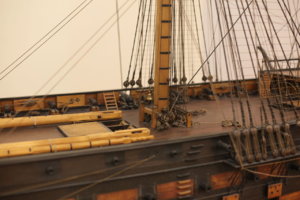
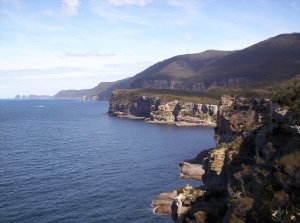
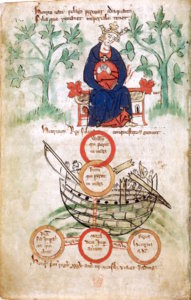

 bulletins of casualties and damage were sold all over England – a novelty at that time. The
bulletins of casualties and damage were sold all over England – a novelty at that time. The 
